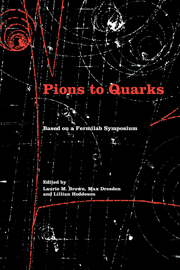Book contents
- Frontmatter
- Contents
- List of contributors
- Foreword by Leon M. Lederman
- Editors' acknowledgments
- Photographs of the symposium
- List of abbreviations
- List of notation
- I Introduction
- II Particle discoveries in cosmic rays
- III High-energy nuclear physics
- IV The new laboratory
- V The strange particles
- 19 The hydrogen bubble chamber and the strange resonances
- 20 A particular view of particle physics in the fifties
- 21 Strange particles
- 22 Strange particles: production by Cosmotron beams as observed in diffusion cloud chambers
- 23 From the 1940s into the 1950s
- VI Weak interactions
- VII Weak interactions and parity nonconservation
- VIII The particle physics community
- IX Theories of hadrons
- X Personal overviews
- Name index
- Subject index
21 - Strange particles
Published online by Cambridge University Press: 07 May 2010
- Frontmatter
- Contents
- List of contributors
- Foreword by Leon M. Lederman
- Editors' acknowledgments
- Photographs of the symposium
- List of abbreviations
- List of notation
- I Introduction
- II Particle discoveries in cosmic rays
- III High-energy nuclear physics
- IV The new laboratory
- V The strange particles
- 19 The hydrogen bubble chamber and the strange resonances
- 20 A particular view of particle physics in the fifties
- 21 Strange particles
- 22 Strange particles: production by Cosmotron beams as observed in diffusion cloud chambers
- 23 From the 1940s into the 1950s
- VI Weak interactions
- VII Weak interactions and parity nonconservation
- VIII The particle physics community
- IX Theories of hadrons
- X Personal overviews
- Name index
- Subject index
Summary
The earliest accelerator results involving a substantial number of strange particles were obtained at Brookhaven National Laboratory in Upton, Long Island, New York, at the Cosmotron, beginning in 1954. I was fortunate to be a part of that work, which I shall now describe.
By the time the 1954 Rochester conference took place, there appeared to be a number of distinct strange particles. Table 21.1 lists the strange particles as known in that year, my first at Brookhaven. Notice that there is an entry for neutral τ and for an anomalous θ0 that “could be a three-body decay.” Both Λ0 and θ0 were firmly established, and their properties were somewhat clearer than they had been in the past. The next few years saw things become clearer still, largely because of work done at the Brookhaven Cosmotron.
Figure 21.1 shows the setup of experiments at the Cosmotron in that summer of 1954. There were pion beams for total-cross-section measurements with counters. The visual detectors were emulsions and cloud chambers; a few years later they had been displaced by bubble chambers. All those devices were set up to study strange-particle production cross sections and properties. Among other things, K- mesons were put into emulsion. John Hornbostel and Edward Salant showed that K- produce hyperons and estimated a geometric value for the interaction mean free path.
In the early 1950s the most important experimental results were those of William B. Fowler, Ralph Shutt, Alan Thorndike, and William Whittemore with π- in a hydrogen diffusion chamber.
- Type
- Chapter
- Information
- Pions to QuarksParticle Physics in the 1950s, pp. 331 - 342Publisher: Cambridge University PressPrint publication year: 1989
- 1
- Cited by



